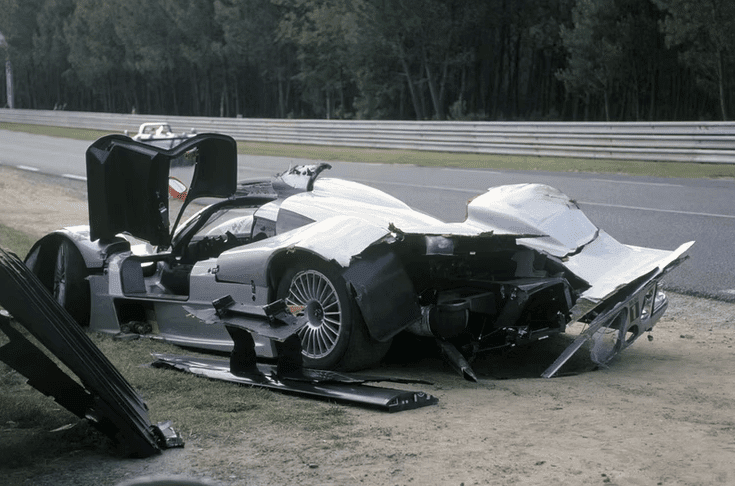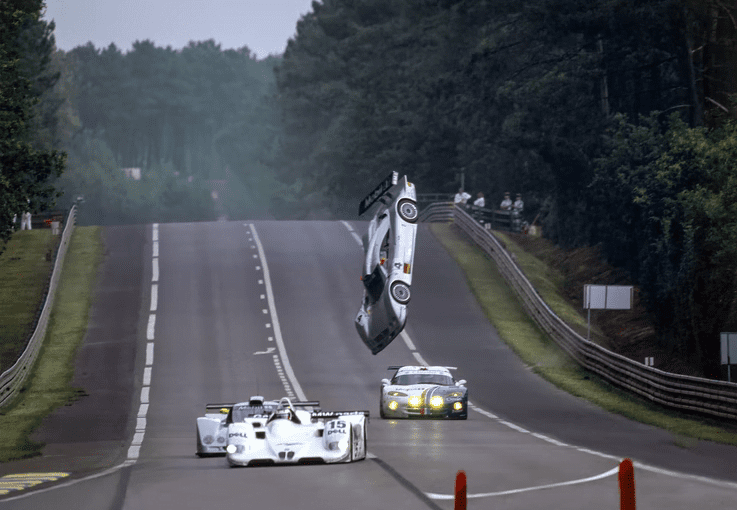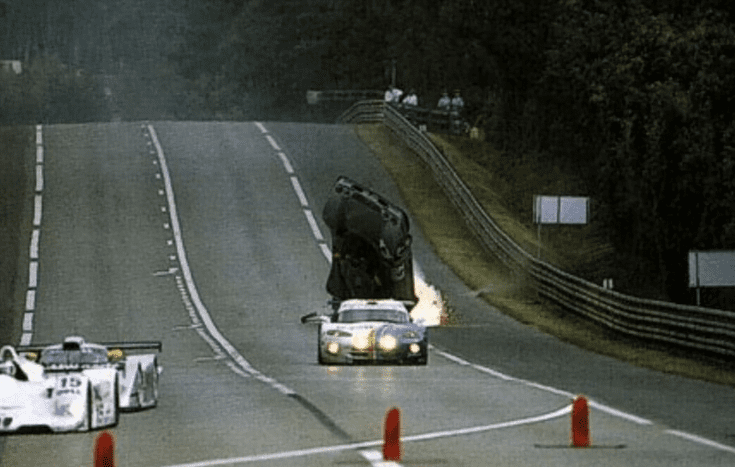“I Believe I Can Fly”
The 24 Hours of Le Mans is one of the most famous endurance races for 24 hours straight. It goes through the dangerous night, through tight corners while reaching a top speed of 200 mph on the Mulsanne straight, not knowing whether your brakes would fail coming up to that first corner. It was a test against the drivers and most importantly the manufacturer’s engineering. Although, the 1999 24 Hours of Le Mans proved to be a very… striking one. For many reasons. As it is known, Mercedes has had a very significant stance in the 24-hour race and motorsport of its self. Yet, one specific year, the German manufacture failed immensely. Mercedes’ failures are very uncommon, but when they fail, they fail abundantly. So what really went wrong for Mercedes?
Well, it was the year 1999. And Mercedes-Benz had just revealed their all-new racing car developed with Mercedes-AMG. It was called the Mercedes-Benz CLR. One of the most famous Mercedes racing cars… but let’s just say, it isn’t known for the right reason. Since Mercedes retired all their cars in the 1998 Le Mans, in 1999 they wanted to prove something during one of the most famous motorsport events. And they definitely did prove something.
Mercedes wanted to be on the top step again. So they made this, the Mercedes CLR, a very slick and smooth designed race car. The CLR was part of the evolution of the infamous CLK GTR models. Although, it was completely different from its 90s predecessor. During testing, the CLR wasn’t really that satisfactory nor was it awful. Nevertheless, on Thursday qualifying awful isn’t even the right word to describe it. Formula 1 driver, Mark Webber was driving in the number 4 Mercedes, the Aussie would have never expected how wrong qualifying was about to turn out. The Mercedes CLR out of the blue launched into the air while flipping over and landing back onto the track. Even though there is no filmed evidence of this, Mark explained the horrific moment.
“I did flip and I saw the sky and the ground and the sky and the ground. so it was a horrible experience and the car was very good in terms of the impact, but obviously that those cars were dangerous in that situation.” mark webber
The Mercedes CLR was very safe in the situation of an accident, but in everything else, it was the exact opposite of safe. After Mark’s crash, Mercedes did make a few changes to the rear suspension, they also added some cascades to the fenders for more downforce. Unfortunately, there was no time to improve, so those little added changes didn’t really make a difference.
If Mercedes were told before that this would happen, they wouldn’t believe their eyes. And yet again during the warm-up session, Mark Webber took off and was launched into the air for the second time that week. I can’t even imagine the frustration and horror that Mark went through. Probably why he never returned to Le Mans since 1999, until Porsche convinced him to return. Anyways, Mark flipped through the air and thankfully avoided the track. He flew into the trees and landed back on the track again this time he landed on his roof. Thankfully, Mark escaped unharmed. That’s one Mercedes out of the race, now let us get to the other one.
Peter Dumbreck was in the number 5 CLR. Now, at this specific moment, Mercedes wasn’t too sure if there was something really wrong with the CLR. So they were reliant on number 5 to bring them to the top step of the podium. They definitely got to the top alright. Yet again, horror-struck. Five hours into the 24-hour race, lap 75, the unpreventable occurred as the second Mercedes CLR was shot into the air again, flipping over three times. You heard that right… a triple flip into the air. It went over the barrier landing into the trees and back onto earth. Peter thankfully made it out and was taken to the hospital. But, Mercedes had a bigger problem to deal with.
Good evening everyone, you are flying with Mercedes International Airport. We have taken off! Never mind, we’re back on the runway again…
BUT WHY DID THE CLR DO THIS?
Good question. It is a question many have asked these past few years and decades. The automotive YouTube channel, Chain bear, has answered that question. So let us break it down. If you are a car enthusiast, a racing fan, or just a nerd for engineering you may know the term, drag. Drag is a force that acts parallel and in the same direction as the airflow, drag slows down a vehicle moving at high speeds. That is why reducing drag as much as possible is important. Although, there is a fine line between reducing some drag, and messing with the downforce. Downforce is a force that pushes the car down. Downforce assists the car to stay on the ground, to go faster, and to grip on the track. Components of downforce include rear spoilers, wings, and diffusers to help generate downforce, but they also increase drag.
Mercedes wanted the CLR to be a very sleek, smooth, and slippery race car with very little drag. No drag equals decreased downforce parts, no downforce parts mean no downforce, which means no force pushing the car to the ground. They wanted the CLR to be so quick without anything disturbing it that they almost took all the downforce components away. And the Circuit de la Sarthe is a track filled with pots holes and some big elevation changes which did not do Mercedes justice. Besides, the downforce wasn’t the only issue adding up to this horrendous car. A car and a race car is supposed to have aerodynamic stability, but also a balance in the body and car. Every car is made to be equally proportionate, when a car is equally spread out between the parts, it is stable. As you can tell, Mercedes messed with the proportions of the CLR.
While racing on the Le Mans circuit, the cars have to go under immense pressure. Such as hard braking corners, full-throttle straights, fast corners, and fast chicanes. It is a test of power in a car, but it is also a test of how that car can handle that power on such a difficult and extreme track. The race cars need to have a balanced trade-off between having low drag to reach insane top speeds but also having downforce to go through the high-speed corners and chicanes. Somehow Mercedes didn’t think of that, and they only thought of reducing drag.
Remember when I mentioned proportions? Well, I’m mentioning them again. The Mercedes CLR’s and most race cars during this era had very long bodies. It’s common sense that if you have a long car, the wheelbase should be longer and wider, so it keeps the car planted, right? Yes, you’re right, but Mercedes did the opposite. They shortened the CLR’s wheelbase, making it a short wheelbase car. That specific thing ruined the proportions of the car, making it weirdly unstable. This increased the car’s overhangs and made the CLR very unstable through the fast corners, which also caused the car to rock back and forth. Also, there were barely any front and rear diffusers to keep downforce due to Mercedes again, wanting to reduce drag.
The Mercedes would rock back and forth while exiting and entering corners, braking, and accelerating. And when Mark and Peter ran into the slipstream of another car it disrupted the front downforce, causing Mark and Peter’s car degrees to rise so frightfully that the cars flipped into the air. After Peter’s crash, they realized it was their car’s fault, not Marks. Mercedes pulled out of the race, and have not returned since. The only thing I can take away from this deranged event, is that I didn’t know Mercedes had a fly suspension setting?





